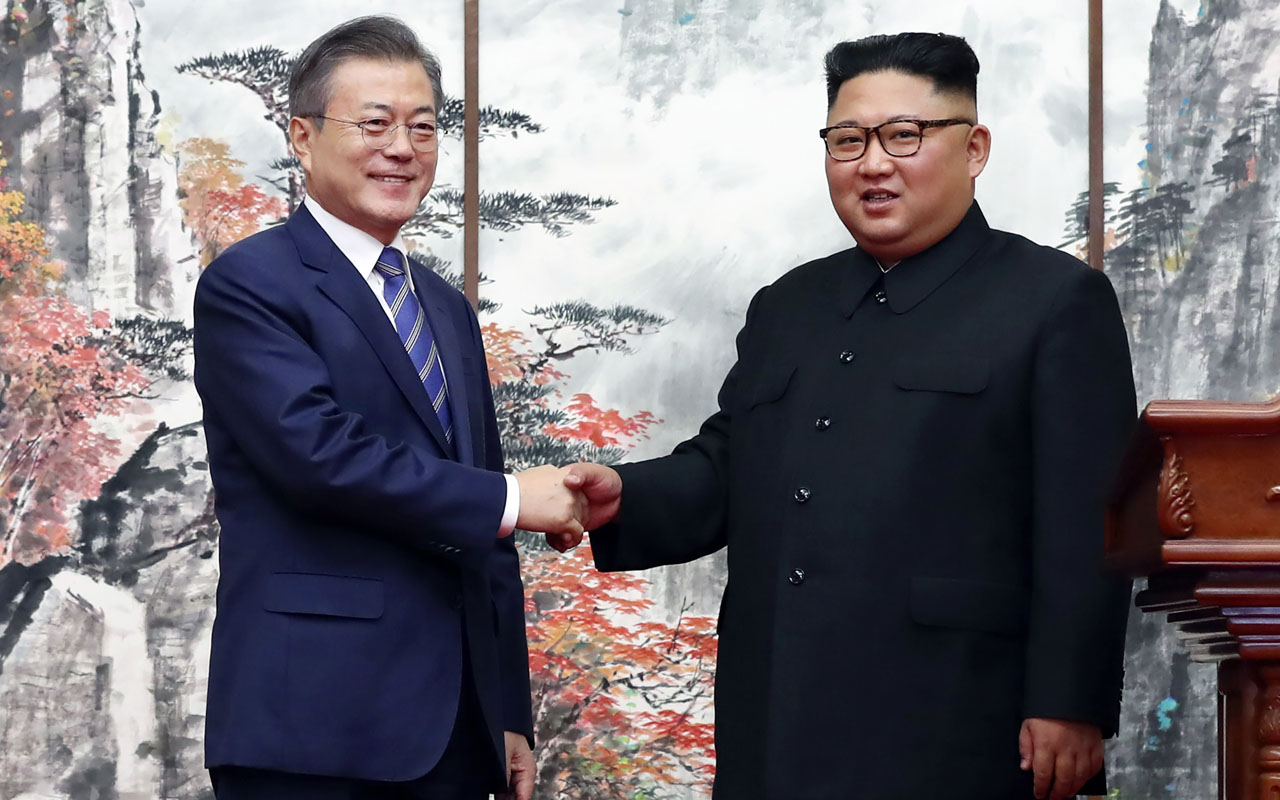

South Korean President Moon Jae-in (L) shakes hands with North Korean leader Kim Jong Un during a joint press conference after their summit at Paekhwawon State Guesthouse in Pyongyang on September 19, 2018. North Korea's Kim Jong Un will soon make a historic visit to Seoul, he said on September 19, and has agreed to close a missile testing site in front of international inspectors, as a rare inter-Korean summit unfolded in Pyongyang. / AFP PHOTO / Pyeongyang Press Corps / - /
North Korea's Kim Jong Un agreed to make a historic visit to Seoul soon and close a missile testing site in front of international inspectors at a summit with the South's President Moon Jae-in in Pyongyang Wednesday.
Progress on the key issue of the North's nuclear arsenal was limited, but the two signed a document to strengthen ties between the two halves of the divided peninsula.
Building on a growing rapprochement, they agreed to create a facility to hold family reunions at any time, work towards joining up road and rail links, and mount a combined bid for the 2032 Olympics.
The agreement "carries the people's fresh hope and the people's strong, flaming desire for reunification", Kim said.
His trip to Seoul would be the first by a Northern leader since the end of the 1950-53 Korean War, when hostilities ceased with an armistice rather than a peace treaty, leaving them technically in a state of war.
Moon added that the visit could happen this year and would be a "monumental milestone in inter-Korean relations".
In their agreement, the North also agreed to "permanently close" a missile engine testing site and launch facility in Tongchang-ri "in the presence of experts from relevant nations".
Moon, who brokered Kim's historic summit with US President Donald Trump in Singapore in June, had hoped to bring fresh momentum to stalled talks between his hosts and Washington.
Whether that would happen remained unclear.
In Singapore Kim declared his backing for denuclearisation of the peninsula but no details were agreed. Washington and Pyongyang have since sparred over what that means and how it will be achieved.
Trump welcomed Wednesday's declaration, tweeting that Kim had "agreed to allow Nuclear inspections, subject to final negotiations" and adding: "Very exciting!"
But experts were sceptical.
'Short of expectations'
The North -- whose ballistic missile programme is banned under UN Security Council resolutions -- has carried out several long-range rocket launches from the site, also known as Sohae, but has also used many other locations including Pyongyang airport.
Satellite pictures in August suggested workers were already dismantling an engine test stand at Sohae.
"Kim is playing this brilliantly: verify that I dismantle a single site that I no longer need anyway while I mass-produce the missiles the site helped me develop," said Vipin Narang of MIT.
Moon also said the North could close its Yongbyon nuclear plant if Washington takes "corresponding measures" -- a significant caveat.
Arms control expert Jeffrey Lewis said the consensus view was that the uranium enrichment facility at Yongbyon "was built for (the) express purpose of being sacrificed".
After the high symbolism of Moon and Kim's first meeting in April in the Demilitarized Zone, and the Singapore summit, progress has largely stalled.
Washington is pressing for the North's "final, fully verified denuclearisation", while Pyongyang wants a formal declaration that the Korean War is over and has condemned "gangster-like" demands for it to give up its weapons unilaterally.
Ahead of the Pyongyang summit there had been speculation Moon could secure a promise from Kim of a list of the North's nuclear assets, but no such document was mentioned.
"On the denuclearisation issue, the agreement fell short of expectations," Korea University political science professor Yoo Ho-yeol told AFP.
Wednesday's declaration came 13 years to the day after the North committed at the Six Party Talks to "abandoning all nuclear weapons and existing nuclear programmes".
Mass applause
But the two Koreas have been pressing ahead with their own rapprochement, with Kim looking to secure economic cooperation from the far wealthier South, and Moon trying to reduce the risk of a US-North Korean conflict that would devastate his country.
The Rodong Sinmun newspaper, the mouthpiece of the North's ruling party, has carried dozens of photos of the two leaders embracing on Moon's arrival Tuesday, parading together through the streets of the capital, enjoying a concert and toasting at a banquet.
On Wednesday evening Moon's party will dine at a new fish restaurant in Pyongyang opposite Mansu hill, where giant statues of Kim's predecessors -- his grandfather Kim Il Sung and father Kim Jong Il -- look out over the city.
It was chosen after Moon expressed interest in dining at a local restaurant with ordinary citizens. However, a retail shop there sells North Korean caviar at $50 for a 50-gramme jar -- a luxury far beyond the reach of most North Koreans.
Afterwards, Moon will attend a performance of the "Mass Games" -- North Korea's spectacular propaganda display featuring tens of thousands of performers against an ever-changing backdrop, made up of 17,490 children turning the coloured pages of books in sequence.
The premiere of the latest version of the show, called "The Glorious Country", earlier this month featured video footage of Moon and Kim together at their first summit in Panmunjom -- prompting the unusual sight of tens of thousands of North Koreans applauding images of the South's president.
Before returning home on Thursday, Seoul said, Moon will travel to Mount Paektu, the spiritual birthplace of the Korean nation on the Chinese-North Korean border.


0 Comments